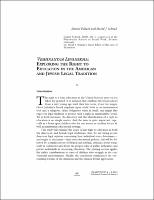Please use this identifier to cite or link to this item:
https://hdl.handle.net/20.500.12202/4588Full metadata record
| DC Field | Value | Language |
|---|---|---|
| dc.contributor.author | Pollack, Daniel | - |
| dc.contributor.author | Schnall, David J. | - |
| dc.contributor.editor | Carmy, Shalom | - |
| dc.date.accessioned | 2019-08-06T23:20:11Z | - |
| dc.date.available | 2019-08-06T23:20:11Z | - |
| dc.identifier.citation | Pollack, Daniel and Schnall, David J. (2003). Veshinantam Levanekha: Exploring the Right to Education in the American and Jewish Legal Tradition. Tradition. 37(4) Jewish Education: A Special Issue. | en_US |
| dc.identifier.issn | 0041-0608 | - |
| dc.identifier.uri | http://traditionarchive.org/news/_pdfs/Pollack-Schnall.1.pdf | en_US |
| dc.identifier.uri | https://hdl.handle.net/20.500.12202/4588 | - |
| dc.description | Scholarly article. Later reprinted in The Azrieli Papers: Dimension of Orthodox Day School Education. Ed. by David J. Schnall and Moshe Sokolow. NY: Michael Scharf Publication Trust of Yeshiva University Press, 2011: 1-21. | en_US |
| dc.description.abstract | The right to a basic education in the United States is more or less taken for granted. It is assumed that children will attend school from a very young age until their late teens, if not for longer. Given Judaism's broad emphasis upon study both as an instrumental tool and a religious, often obligatory value in itself, one might also expect its legal tradition to project such a right in unmistakable terms. Yet in both instances, the discovery and the identification of a right to education is no simple matter. And the issue is quite important, especially as it bears upon children who for one reason or another do not fit well in mainstream educational settings.---/ This study will examine the scope of any right to education in both the American and Jewish legal traditions; first, by surveying recent American legal opinion concerning how individual states determine -- and ought to determine -- their own educational policies; this will be followed by a parallel survey of biblical and rabbinic attitudes about where study is conducted and about the proper roles of public authorities and private individuals in overseeing education. The ensuing section applied the earlier considerations to cases of children who struggle in the conventional environments. Finally, the conclusion summarizes the outstanding features of teh American and teh classical-Jewish approaches. | en_US |
| dc.language.iso | en_US | en_US |
| dc.publisher | Rabbinical Council of America | en_US |
| dc.relation.ispartofseries | Tradition;37(4) | - |
| dc.rights | Attribution-NonCommercial-NoDerivs 3.0 United States | * |
| dc.rights.uri | http://creativecommons.org/licenses/by-nc-nd/3.0/us/ | * |
| dc.subject | Right to education | en_US |
| dc.subject | Jewish legal tradition | en_US |
| dc.subject | San Antonion Independent School District v. Rodriguez | en_US |
| dc.subject | Plyler v. Doe | en_US |
| dc.subject | Rose v. council for Better Education, Inc. | en_US |
| dc.subject | Wilkinsburg v. Wilkinsburg Education Association | en_US |
| dc.subject | private schools | en_US |
| dc.subject | Hutchenson v. Grace Lutheran School | en_US |
| dc.subject | Flint v. St. Augustine High School | en_US |
| dc.subject | Zero Tolerance Laws | en_US |
| dc.subject | Talmud Torah | en_US |
| dc.subject | Mandate to educate women | en_US |
| dc.subject | Ben-Gamla --Retention of teachers | en_US |
| dc.subject | the problem child | en_US |
| dc.subject | Rabbi Abraham Karelitz | en_US |
| dc.title | Veshinantam Levanekha: Exploring the Right to Education in the American and Jewish Legal Tradition. | en_US |
| dc.type | Article | en_US |
| Appears in Collections: | The Azrieli Papers. | |
Files in This Item:
| File | Description | Size | Format | |
|---|---|---|---|---|
| Pollack-Schnall.1.pdf | From Tradition website | 124.16 kB | Adobe PDF |  View/Open |
This item is licensed under a Creative Commons License

